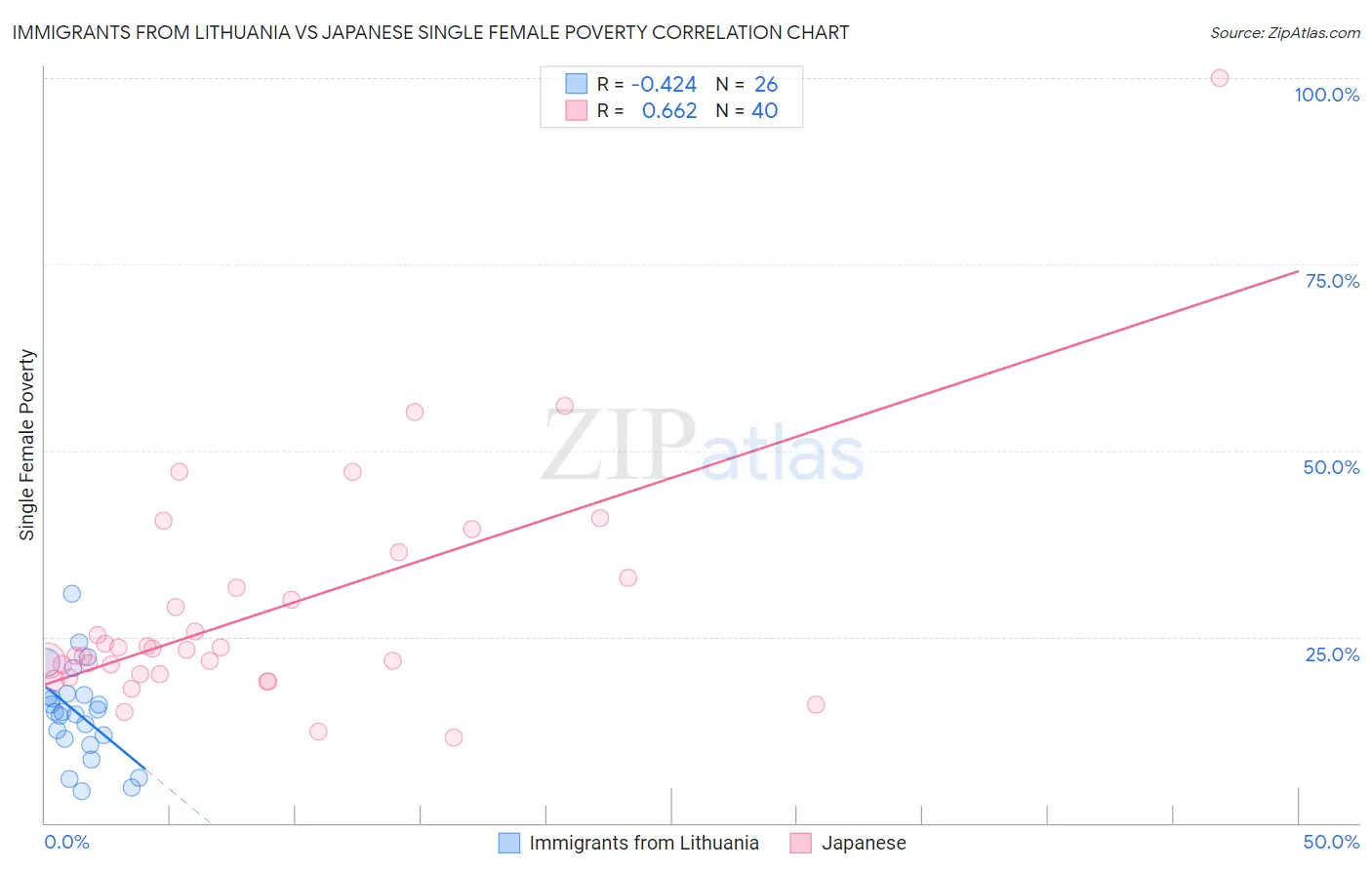Immigrants from Lithuania vs Japanese Single Female Poverty
COMPARE
Immigrants from Lithuania
Japanese
Single Female Poverty
Single Female Poverty Comparison
Immigrants from Lithuania
Japanese
17.8%
SINGLE FEMALE POVERTY
100.0/ 100
METRIC RATING
11th/ 347
METRIC RANK
21.3%
SINGLE FEMALE POVERTY
26.4/ 100
METRIC RATING
197th/ 347
METRIC RANK
Immigrants from Lithuania vs Japanese Single Female Poverty Correlation Chart
The statistical analysis conducted on geographies consisting of 116,892,262 people shows a moderate negative correlation between the proportion of Immigrants from Lithuania and poverty level among single females in the United States with a correlation coefficient (R) of -0.424 and weighted average of 17.8%. Similarly, the statistical analysis conducted on geographies consisting of 247,508,626 people shows a significant positive correlation between the proportion of Japanese and poverty level among single females in the United States with a correlation coefficient (R) of 0.662 and weighted average of 21.3%, a difference of 20.0%.

Single Female Poverty Correlation Summary
| Measurement | Immigrants from Lithuania | Japanese |
| Minimum | 4.2% | 11.5% |
| Maximum | 30.7% | 100.0% |
| Range | 26.6% | 88.5% |
| Mean | 14.7% | 28.5% |
| Median | 14.9% | 23.4% |
| Interquartile 25% (IQ1) | 11.3% | 19.9% |
| Interquartile 75% (IQ3) | 17.2% | 32.3% |
| Interquartile Range (IQR) | 6.0% | 12.3% |
| Standard Deviation (Sample) | 6.2% | 15.9% |
| Standard Deviation (Population) | 6.1% | 15.7% |
Similar Demographics by Single Female Poverty
Demographics Similar to Immigrants from Lithuania by Single Female Poverty
In terms of single female poverty, the demographic groups most similar to Immigrants from Lithuania are Immigrants from South Central Asia (17.8%, a difference of 0.060%), Immigrants from Ireland (17.8%, a difference of 0.090%), Immigrants from Bolivia (17.8%, a difference of 0.32%), Bhutanese (17.7%, a difference of 0.50%), and Bolivian (17.9%, a difference of 0.76%).
| Demographics | Rating | Rank | Single Female Poverty |
| Immigrants | India | 100.0 /100 | #4 | Exceptional 16.8% |
| Assyrians/Chaldeans/Syriacs | 100.0 /100 | #5 | Exceptional 17.0% |
| Filipinos | 100.0 /100 | #6 | Exceptional 17.0% |
| Thais | 100.0 /100 | #7 | Exceptional 17.3% |
| Immigrants | Iran | 100.0 /100 | #8 | Exceptional 17.5% |
| Bhutanese | 100.0 /100 | #9 | Exceptional 17.7% |
| Immigrants | Ireland | 100.0 /100 | #10 | Exceptional 17.8% |
| Immigrants | Lithuania | 100.0 /100 | #11 | Exceptional 17.8% |
| Immigrants | South Central Asia | 100.0 /100 | #12 | Exceptional 17.8% |
| Immigrants | Bolivia | 100.0 /100 | #13 | Exceptional 17.8% |
| Bolivians | 100.0 /100 | #14 | Exceptional 17.9% |
| Indians (Asian) | 100.0 /100 | #15 | Exceptional 17.9% |
| Iranians | 100.0 /100 | #16 | Exceptional 18.0% |
| Immigrants | Korea | 100.0 /100 | #17 | Exceptional 18.1% |
| Immigrants | Eastern Asia | 100.0 /100 | #18 | Exceptional 18.1% |
Demographics Similar to Japanese by Single Female Poverty
In terms of single female poverty, the demographic groups most similar to Japanese are Immigrants from Saudi Arabia (21.3%, a difference of 0.060%), Nicaraguan (21.3%, a difference of 0.090%), Czechoslovakian (21.3%, a difference of 0.10%), Basque (21.3%, a difference of 0.13%), and Swiss (21.4%, a difference of 0.17%).
| Demographics | Rating | Rank | Single Female Poverty |
| Trinidadians and Tobagonians | 35.2 /100 | #190 | Fair 21.2% |
| Immigrants | Germany | 31.1 /100 | #191 | Fair 21.3% |
| Immigrants | Jamaica | 30.5 /100 | #192 | Fair 21.3% |
| Basques | 28.1 /100 | #193 | Fair 21.3% |
| Czechoslovakians | 27.7 /100 | #194 | Fair 21.3% |
| Nicaraguans | 27.6 /100 | #195 | Fair 21.3% |
| Immigrants | Saudi Arabia | 27.1 /100 | #196 | Fair 21.3% |
| Japanese | 26.4 /100 | #197 | Fair 21.3% |
| Swiss | 24.2 /100 | #198 | Fair 21.4% |
| Immigrants | Immigrants | 22.0 /100 | #199 | Fair 21.4% |
| Irish | 21.4 /100 | #200 | Fair 21.4% |
| Nigerians | 20.9 /100 | #201 | Fair 21.4% |
| Immigrants | Kenya | 20.7 /100 | #202 | Fair 21.4% |
| Immigrants | Haiti | 18.8 /100 | #203 | Poor 21.5% |
| Immigrants | Africa | 16.7 /100 | #204 | Poor 21.5% |